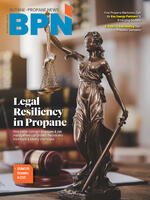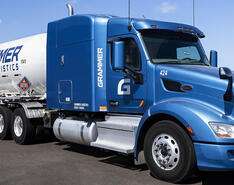
Rebranding in the propane industry is more than a new logo or name. It’s a reset button — a rare opportunity to align how your propane company is seen with where your company is headed. But in an industry where legacy, loyalty and word of mouth carry weight, a rebrand can feel like risky business.
We get it. At Navara Marketing, for example, we recently went through a rebrand ourselves. After years of collaborating, we merged two industry-specialized agencies, Maderia Group and L4 Group, into one unified brand.
As we learned, the rebrand process was strategic, methodical and, at times, humbling. But the end result for any company working on the rebranding process is clarity — for the company, for the team and, most importantly, for the clients.
If you’re a propane dealer thinking about a rebrand or even just wondering if it’s time, this guide will walk you through what to consider. We’ll share real-world insights from our transition and offer practical advice so you can rebrand with confidence.
When Should a Propane Company Rebrand?
Not every business needs a rebrand. But here are signs it might be time:
- You’re growing into new markets, and your name doesn’t reflect your service area anymore.
- You’ve acquired another company or are going through a generational leadership transition.
- Customers don’t remember your name or confuse you with competitors.
- Your visual identity feels outdated, especially compared to competitors with modern websites, trucks and signage.
- You’ve outgrown your original mission and need to reflect a broader service offering beyond propane (HVAC, plumbing, etc.).
Rebranding is not about change for the sake of change. It’s about realignment: making sure your external identity reflects your internal vision. Ahead are six steps to take when setting out on the rebranding journey.
Step 1: Clarify Your ‘Why’
Before you hire a designer or brainstorm new names, ask yourself one critical question: “Why are we rebranding?”
The answer will shape every other decision. At Navara, for instance, the “why” was simple: Two companies had been operating side by side, serving the same clients in the energy space. We were already collaborating, but the split identity created confusion and inefficiency. We needed one brand to represent one team, one voice and one mission.
Whether your reason is growth, consolidation or modernization, make sure it’s rooted in business strategy, not personal preference.
Step 2: Nail Down the Strategy
Once your “why” is clear, define your brand positioning. This is your compass.
- Who are your ideal customers now and in the future?
- What makes you different from other dealers in your area?
- What do you want people to feel when they hear your name?
This is also the stage to get input from key stakeholders. Interview your best customers. Talk to your employees. Review competitor branding in your region. This feedback will guide your messaging and design choices.
Step 3: Choose a Name You Can Own
This may be the hardest part. In our case, we learned quickly that trademarking a generic name would be nearly impossible. So, we took a different path and created a name from scratch: Navara.
The name we created is rooted in the word “navigate,” reflecting our mission to guide clients through marketing decisions with clarity and momentum. It’s easy to pronounce, visually clean and trademarkable. In a similar vein, here’s what to consider if you’re choosing a new name:
- Check domain availability and social handles.
- Do a trademark search through the United States Patent and Trademark Office.
- Avoid descriptive names that box you in or mirror existing competitors.
In the short-term, a unique name may feel unfamiliar. But long term, it creates space for your brand to grow.
Step 4: Build a Visual Identity That Feels Like You
This is where it starts to get fun, but don’t skip the strategy.
Your logo, colors and typography should feel aligned with your customer base. If you serve a high-end residential clientele, your visuals should reflect that level of polish. If you’re all about speed and reliability for commercial accounts, your look should feel bold, efficient and trustworthy. Don’t forget these essentials:
- Logo and brand marks for print, web and vehicles
- Truck wrap designs with high readability at a distance
- Uniform updates for field staff and drivers
- Digital assets like a modern website and updated email signatures
- Physical assets like letterhead, building signage and billboards
It’s often worth hiring a branding expert familiar with the propane space. It saves time and prevents costly mistakes.
Step 5: Prepare Internally Before You Announce
What’s one of the biggest mistakes companies make during a rebrand? Announcing it before their team is ready. Before you go public, make sure:
- Every team member knows the new brand story and how to talk about it
- All paperwork, invoices and digital tools reflect the change
- Your customer service team is trained to answer questions and reinforce continuity
At Navara, we had weekly internal check-ins to coordinate updates and identify gaps. We created brand launch kits and mapped every place the old brand existed, down to forgotten PDFs.
Step 6: Communicate Clearly With Customers
The launch is not just a reveal. It’s a relationship moment. Here’s how to roll it out effectively:
- Send a personal letter or email from the owner explaining the change.
- Update your website with a banner or FAQ section about the rebrand.
- Use postcards or flyers with delivery invoices to reinforce the message.
- Post on social media with photos of new trucks or branded gear.
- Answer the question: “What does this mean for me?” Reassure customers that pricing, service and team members remain the same.
Rebranding is a chance to reconnect. Use it to thank customers, tell your story and reinforce trust.
The Pros & Cons of Rebranding
As you’re considering a rebrand, think through any pros and cons.
Pros:
- Stronger positioning: You stand out in a crowded market.
- Improved recall: A memorable name is easier to refer and recommend.
- Team alignment: A rebrand can reenergize your culture.
- Digital momentum: Modern visuals and messaging can improve website traffic and conversions.
Cons:
- Cost and time: Rebranding takes resources and can feel overwhelming.
- Customer confusion: If not communicated well, it can create short-term doubt.
- Operational lift: You’ll need to update signage, forms, systems and more.
The key is preparation. The more thorough your planning, the smoother the transition.
Rebranding in the Propane Industry With Intention
At Navara, we didn’t rebrand because it was trendy. We rebranded because it was necessary. It aligned our team, sharpened our message and positioned us to better serve our clients.
If you’re considering a rebrand, take your time. Get clear on your goals. Build a plan. And surround yourself with people who know how to guide the process.
Because when it’s done right, a rebrand isn’t just cosmetic — it’s transformative.


